Port Authorities
-
- AMERICA'S SEAPORTS The Dynamics Of Change Maritime Reporter, Aug 1986 #16
For more than three centuries, America's seaports have been centers of population, trade, and vibrant economic activity. Within the past three years, the U.S. seaport industry has emerged from the throes of recession, and today, in many respects, is as healthy and optimistic as it has ever been. Problems remain, to be sure. Not all of our ports have shared in the renewed prosperity. Major legislative questions still await resolution. But basically the news is good. And that is good news—not only for our ports, but for the economic regions they serve and for the national economic and security interests of the United States, as well.
The industry itself is vast, versatile, vibrant, and highly competitive.
The United States is served by 183 deepdraft commercial seaports dispersed along the Atlantic, Pacific, Gulf, and Great Lakes coasts.
Included in that number, too, are the ports of Alaska, Hawaii, Puerto Rico, and the Virgin Islands. In 1984, America's ports accommodated just over 1.2 billion tons of cargo in the U.S. foreign, domestic ocean, Great Lakes, intercoastal and coastwise trades.
Foreign trade is essential to the United States. The United States annually exports more than 10 percent of its coal production, nearly 40 percent of its wheat and wheat flour, 35 percent of its rice, and 40 to 50 percent of its cotton. About 10 percent by value of U.S. manufacturers are also sold in foreign markets.
Equally important, exports mean jobs—American johs. Barely 20 years ago, one in 14 American manufacturing workers were engaged in making products for exports. Today, that ratio stands at one in six— an increase of 130 percent. From 1977 to 1980, four out of every five new jobs created in the U.S. manufacturing sector were export related.
America's dependence on imports is equally strong, particularly the strategic materials so essential to its national defense industries. The United States relies heavily on imported minerals—iron ore, petroleum, bauxite, natural rubber, tin, tungsten, cobalt, and manganese, for example. Imported goods and services contribute to the stocks available to American consumers.
The processing and distribution of imported goods also generates jobs and income for Americans. Moreover, selling to the United States enables foreign nations to earn the dollars they need to buy American goods and services.
Trade is important. Even more to the point, however, is the fact that more than 95 percent of U.S. overseas merchandise trade by volume and approximately 70 percent by value moves in deepdraft, oceangoing vessels. Consequently, the successful conduct of U.S. foreign waterborne commerce is vitally dependent on the services and facilities provided at U.S. seaports. For many shippers, particularly those involved in the bulk movement of coal, grain, liquids, and the like, there is simply no economical alternative to ocean transport.
Ports are also essential to national security. Major naval installations are located at a number of U.S.
ports—a number that will increase if the U.S. Navy's current strategic homeporting initiative comes to fruition. U.S. Marine Corps units are regularly rotated through the ports of San Diego and Moorehead City. Two dozen U.S. ports have been designated by the Department of Defense for use in the initial deployment and resupply of U.S.
forces abroad. A number of U.S.
commercial ports are also regular participants in military exercises, such as the annual REFORGER exercises in Europe.
Ports have had a central role in virtually every major U.S. conflict since the Revolutionary War times.
That has been particularly true in this century, when America's wars have been mostly overseas, with ports serving as staging points for the deployment, supply, reinforcement, and resupply of U.S. forces fighting thousands of miles from our shores. That pattern will almost certainly be repeated in future conflicts.
Indeed, the Joint Chiefs of Staff have stated that a major European war, sealift could bear the brunt of the workload in deployment, reinforcement, and resupply efforts. More specifically, they state: "In any overseas deployment, sealift will deliver about 95 percent of all petroleum products. That implies a need, not only for ships, but for ports to load them. And in most instances, these ships would be loaded at commercial port facilities— at terminals developed, owned, and in many instances operated by state and local port authorities.
The port industry contributes importantly to the national economy in other ways. In 1984, according to the U.S. Maritime Administration, commercial seaport activities generated $60 billion in direct and indirect benefits to the U.S. economy and contributed more than $30 billion to the U.S. Gross National Product. The stevedoring marine terminal component of the port industry alone generated $8.4 billion in revenues and salaries, and employed 138,000 persons. Altogether, seaports accounted for more than a million jobs, and billions of dollars in federal, state, and local taxes.
During the past four years, imported cargo unloaded at U.S. seaports has produced an average of 70 percent of U.S. Customs receipts from duties. That came to $6.5 billion in fiscal 1983, $8.3 billion in fiscal 1984, and an estimated $9.0 billion in fiscal 1985. A 1986 survey by the American Association of Port Authorities (AAPA) revealed, in addition, that U.S. public port authorities were providing U.S. Customs at nominal or, in most cases, at no charge, facilities and services with a total market value of just under $1.5 million annually.
© 1986, Cummins Engine Company, Inc.
The growth of ocean commerce and the revolutionary change in marine technology have placed enormous demands on U.S. public port authorities. Between 1950 and 1984, U.S. port traffic more than doubled in volume, with port handlings of imports and exports alone multiplying sixfold, reaching a peak of just over 1.0 billion tons in 1979. Fueling that growth initially was the postwar economic recovery of Europe Circle 222 on Reader Service Card and Japan, and subsequently, the dramatic rise in imported petroleum and exported grain, and the expansion of U.S. trade with the Soviet Union, the Pacific Rim, and the Middle East.
On the shipping side, the relatively small and undifferentiated merchant- men of two generations ago— the war-built Victory and Liberty ships and T-2 tankers—have been all but totally replaced by huge tankers, drybulk carriers, containership car carriers, refrigerated ships, and a bewildering variety of other highly specialized vessel types.
Ships, on average, have become larger, technologically more sophisticated, and significantly more expensive to build and to operate, requiring equally sophisticated ports to turn them around quickly and keep them on schedule. In response, more than $5 billion was invested in commercial port facilities in the United States from 1946 through 1980. During the period 1973-1983, public port authorities alone invested some $3.0 billion in facilities, and are expected to invest another $3.2 billion in capital improvements between 1983 and 1989, according to the Maritime Administration.
More detail as to the pattern of future investment is provided in Table 1.
Note that the Maritime Administration's forecasts do not include port-related investments by private- sector entities, such as coal, petroleum, and grain companies.
Most public port authorities are general purpose in nature with each catering in varying degrees to all types of cargo, bulk, and nonbulk.
Leading petroleum import centers are the ports of New York and New Jersey, the Delaware River, the lower Mississippi, the Gulf Coast, and southern California. Coal is shipped in greatest volume from Philadelphia, Hampton Roads, Baltimore, Mobile, New Orleans, and certain ports on the Great Lakes. The Gulf, Pacific Northwest, and the Great Lakes are prime grain exporting areas. Log and timber exports are a specialty of the ports in Oregon and the state of Washington, iron ore of the Great Lakes, and tobacco of the ports of Virginia and North Carolina.
Most U.S. ports are equipped with general cargo terminals—facilities at which merchandise is handled in containers, boxes, barrels, and bales. Thousands of imported automobiles are unloaded at various ports on the East, Gulf, and West Coasts. While regular, transoceanic passenger service is largely a historic memory, a number of U.S. ports are finding the expanding cruiseship business to be extremely lucrative and a considerable source of local economic benefit.
The onset of the 1980s brought with it a host of economic difficulties for U.S. ports. Cargo volumes dropped. Foreign cargo at U.S. ports declined from the 1979 peak to a low of 735.1 million tons in 1983. The sharpest decline occurred in petroleum imports, reflected the combined effects of the OPEC price hikes, the recession in the U.S. economy, conservation efforts, and the substitution of coal and other domestic fuels for foreign oil. High unemployment and the depressed state of U.S. industry in general lowered overall demand for goods and services, including those purchased abroad. The soaring value of the U.S. dollar against foreign currency effectively increased the price of U.S. goods and services to foreign purchasers. The worldwide recession made matters worse. Although U.S. coal exports surged in 1980- 1982, that was not enought to cushion the overall drop in trade.
Since 1983, however, there has been a turn around reflecting, in part, the resurgence of the U.S.
economy. In business was good at U.S. ports in 1984, and even better in 1985. Container cargo movements last year reached record highs at many U.S. ports. While petroleum imports and U.S. grain imports remained depressed, the overall picture at U.S. ports is encouraging.
One important factor for U.S. public port authorities has been the continued rise in imported dry cargo, a trend that appears to have continued unabated into the first half of 1986, despite the drop in the dollar.
U.S. coal exports last year hit a near record high of 92.0 million tons; this year promises to be nearly as good, with foreign buyers rushing to take advantage of low prices for U.S.
steam coal. The ongoing OPEC price war appears to have brought a resurgence of U.S. petroleum imports, though volumes are unlikely to ever again reach the peak levels of the 1970s. U.S. grain exports are also expected to recover from last year's dismal performance, reflecting lower U.S. prices engendered by the dollar's fall and the impact of the new farm act. A summary of recent trends in U.S. waterborne imports and exports is provided in Table 2.
Of course, problems remain. The past 10 months have been difficult ones for ports located on the Gulf and Great Lakes, and in the Pacific Northwest. Even though the U.S.
dollar continues to decline, U.S.
trade is still characterized by a heavy imbalance of imports, meaning that ships typically arrive fully laden at U.S. ports and depart empty or partially loaded. Moreover, international shipping is heavily overtonnage in virtually all of the major trades. Stated differently, available shipping capacity is far greater than total available cargo, a problem that will tend to be exacerbated as new buildings enter the market in greater numbers than those removed by scrapping or retirement. Despite the obvious benefits of foreign trade to the U.S.
economy, sentiment persists in Congress and elsewhere for legislation and other governmental actions aimed at curtailing the import of automobiles, steel, lumber products, textiles, and a host of other products.
Federal budgetary problems, particularly those directed at scaling back the enormous national debt, are having their effects on public port management. Examples include reduced manning levels at key federal agencies such as Customs, and limited resource levels for the Coast Guard. In addition, there is an immediate prospect of cost-re- covery, user fee schemes related to a range of federal activities and services all of critical importance to the flow of waterborne commerce.
Agencies involved include the CoTps of Engineers, the Customs Service, the Coast Guard, and the Immigration Naturalization Service. Perhaps most troublesome regarding these user fee schemes is the fact that each user fee scheme has been proposed independently, without an understanding or a recognition of the cumulative impact of all such cost-recovery schemes on the essential flow of U.S. waterborne commerce.
For the past six years, perhaps the most difficult issue for U.S. public port management has been the Reagan Administration's insistence that the traditional federal role in sponsoring most costs involved in new navigation channel construction and channel maintenance must be significantly reduced. After considerable negotiation and debate, the U.S. public port industry has generally accepted the idea that, in return for new channel projects, an increased local nonfederal share of the total project costs will be required.
It should be noted that there has not been an omnibus water projects bill since 1970—nearly 16 years!
Moreover, the public port industry has acknowledged the inevitability of a system of user fees established to recover a portion of the Corps maintenance costs. This radical new port development legislation may be enacted by the time this article is published. Clearly, one potential advantage of increased local cost-sharing for federal navigation channel projects is the prospect of greatly speeding up the process by which those projects are approved, funded, and constructed which now takes, on average, more than 25 years.
In spite of these increased cost burdens proposed to be placed on U.S. public port authorities at the federal level, the Reagan Administration and certain members of Congress had proposed, within the rationale of "tax-reform", legislation that would have virtually eliminated the ability of public port authorities to use tax-exempt bonds to finance port facility development.
Wisely, both houses of Congress have recognized the fundamental importance of continuing the taxexempt bond financing capabilities of public ports in tax-reform legislation that is (as of this writing) now in Senate/House Conference Committee.
Certain restrictions still need to be resolved, but the basic public purpose of public port authorities to develop facilities needed to serve the essential flow of U.S.
waterborne commerce has again been confirmed by the U.S. Congress.
In short, the outlook for the U.S.
public port industry is positive. U.S.
public port authorities continue to demonstrate their ability to fulfill their critical responsibilities in promoting the interests of their local communities, their region, and the nation.
-
- Port Authorities (AAPA) 66th Annual Convention Set For Mexico City Maritime Reporter, Sep 15, 1977 #43
The American Association of Port Authorities (AAPA) will hold its 66th Annual Convention at the Hotel Maria Isabel in Mexico City, October 23-27. According to executive vice president Richard L. Schultz, this 66th convention marks the first AAPA annual meeting to be held in a Latin American country.
-
- Additional Funding Urged for Port Security Maritime Reporter, Nov 2002 #26
U.S. public port authorities discussed the need for Federal legislation and continued Federal funding for maritime security. Urging Congress to appropriate additional funds for Fiscal Year '03 during their Legislative Policy Council (LPC) meeting on September 23, 2002, port authorities met recently
-
- Port Facilities Engineering Seminar Set By AAPA For January 28-30, 1991 Maritime Reporter, Jan 1991 #66
The American Association of Port Authorities (AAPA) will conduct a port facilities engineering seminar January 28-30,1991, in Los Angeles, Calif. The theme of this program is "Dynamics in Design for an Industry on the Move," A wide range of major facilities engineering issues critical to port
-
- AAPA Moves Headquarters To Arlington, Virginia Maritime Reporter, Oct 1984 #6
After 35 years of operations in downtown Washington, D.C., the American Association of Port Authorities has relocated its headquarters to Alexandria, Va., a port city located directly across the Potomac River from the nation's capital. The 6,000-square-foot office building is a part of the new
-
- Op/Ed: Act Now on Port Infrastructure Maritime Logistics Professional, Jul/Aug 2017 #14
for raw materials to get to the U.S. steel industry, and upgrades are critical. $66 billion needed for U.S. ports: American Association of Port Authorities has identified a need for $66 billion in federal investments for critical port-related infrastructure over the next 10 years. Meanwhile, the port
-
- Op/Ed: California's Zero-emission Domino Theory Marine News, Apr 2018 #24
with costs and uncompetitive in a global marketplace. This zero-emission Domino Theory is on full display in California’s maritime industry where port authorities and regulators are working to reduce emissions from port-related activities. California port authorities have led the way in establishing themselves
-
- Cyber Incident Response for the Resilient Organization Maritime Reporter, Apr 2018 #18
Even prior to NotPetya, regulatory bodies, insurers, P&I clubs, port authorities, and other segments of the maritime industry started taking steps to minimize the industry’s exposure to cyberattacks.The maritime industry has had an awakening. We have awoken to the fact that digitalization has woven its
-
- Inside Cruising’s LNG Plunge Maritime Logistics Professional, Jan/Feb 2019 #30
.”Compared to HFO and MGO refueling, there are also differences in terms of the location of bunkering operations and by extension, safety concerns of port authorities. “One of the unique challenges within the cruise industry is that you’re often going into port right in the center of cities. You’re doing bunkering
-
- The Effect Of Ship Design On Ports Maritime Reporter, May 1991 #60
Pacific trade by American President Lines. Suddenly, practically every container crane in the world was obsolete or feared to be obsolete by the port authorities. The new APL ships require a crane boom reach of approximately 140 feet to reach the 16th or outboard rows of containers. The prior standard
-
- INSIGHTS: William D. Friedman Maritime Logistics Professional, Jul/Aug 2018 #14
Port of Cleveland President & CEO and newly elected Board Chairman of the American Association of Port Authorities William Friedman weighs in this month on the Port of Cleveland and its role in the all important Great Lakes trades.When the American Association of Port Authorities (AAPA) announced the
-
- Seafarers Trust in Technology Maritime Logistics Professional, Q1 2016 #48
is also in the process of rolling out the construction of unmanned seafarers’ centers in ports lacking in existing welfare provision. Working with port authorities, unions and other interested stakeholders, these centers will enable seafarers to access the internet in ports on tablet consoles. Together with
-
 )
March 2024 - Marine Technology Reporter page: 45
)
March 2024 - Marine Technology Reporter page: 45, multi-payload mission opera- tions where communications are often denied or restricted. As part of the new alliance, Metron’s Resilient Mission Autonomy portfolio will be integrated into Cellula’s Solus and Imotus families of vehicles to deliver AI-enabled situ- ational awareness and execute real-time onboard
-
 )
March 2024 - Marine Technology Reporter page: 36
)
March 2024 - Marine Technology Reporter page: 36LiPo battery packs are located behind a clear polycarbonate panel mid- body above the thrusters. A second identical set of batteries is located on the port side of the vehicle. Individual battery packs are held in separate pockets machined into the ISOFloat syntactic. Used with Permission, Earthship
-
 )
March 2024 - Marine Technology Reporter page: 35
)
March 2024 - Marine Technology Reporter page: 35sizes, in oil-? lled bags and are commonly available around the world. This is handy to pressures of 20,000psi without if you are in a remote port and need to cobble together a spare damage. Their battery pack. Tip: Don’t rely on spring-loaded battery hold- solid-state BMS ers for critical applicatio
-
 )
March 2024 - Marine Technology Reporter page: 4
)
March 2024 - Marine Technology Reporter page: 4St., New York, NY 10010 return of Oceanology Interna- Tel: (212) 477-6700; Fax: (212) 254-6271 tional in London, perennially one Lof the world’s most important Justin Zuure CEO events serving the global subsea market. John C. O’Malley [email protected] Personally, it was my ? rst return to London
-
 )
April 2024 - Maritime Reporter and Engineering News page: 43
)
April 2024 - Maritime Reporter and Engineering News page: 43, designers, research institutes and class societies: all of them are crucial,” – Eero Lehtovaara, Head of Regulatory & Public Affairs, ABB Marine & Ports All images courtesy ABB Marine and Ports providers on developing standards and print and accelerate the commercialized tection. The work would also
-
 )
April 2024 - Maritime Reporter and Engineering News page: 42
)
April 2024 - Maritime Reporter and Engineering News page: 42the way it crafts maritime legislation to re? ect its place in the interconnected, interdependent world economy, said Eero Lehtovaara, ABB Marine & Ports. ABB Marine & Ports Head of Regula- transporting goods, whether considered eters, for example: a seafarer acting in full tory & Public Affairs, Eero
-
 )
April 2024 - Maritime Reporter and Engineering News page: 41
)
April 2024 - Maritime Reporter and Engineering News page: 41• GMDSS/NAVTEX/NAVDAT coastal surveillance and transmission systems • Offshore NDB non-directional radio beacon systems for oil platform, support vessel & wind farm applications • DGPS coastal differential global positioning systems • VHF port communication systems Nautel and Kenta
-
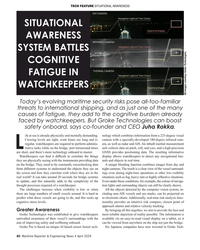 )
April 2024 - Maritime Reporter and Engineering News page: 40
)
April 2024 - Maritime Reporter and Engineering News page: 40, watchkeepers are required to perform adminis- era, as well as radar and AIS. An inbuilt inertial measurement L trative tasks while on the bridge, port turnaround times unit collects data on pitch, roll, and yaw, and a high-precision are short, and there’s more technology onboard to master. GNSS
-
 )
April 2024 - Maritime Reporter and Engineering News page: 38
)
April 2024 - Maritime Reporter and Engineering News page: 38took place at an offshore multiple buoy mooring site near pacity of 485 kWh, Castalia ensures operational autonomy of the BP re? nery, two miles from the Port of Castellón in Spain. up to eight hours, providing an ef? cient and non-polluting solu- Using its electric line handling tug Castalia, Consulmar
-
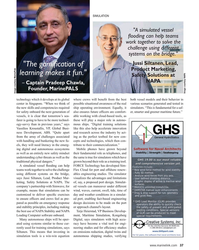 )
April 2024 - Maritime Reporter and Engineering News page: 37
)
April 2024 - Maritime Reporter and Engineering News page: 37as a training tool. A simulated vessel ? ooding can help FORCE Technology has developed Sim- teams work together to solve the challenge Flex Cloud for port and offshore renew- using different systems on the bridge, ables engineering studies. The simulator says Jussi Siltanen, Lead, Product Mar- visualizes
-
 )
April 2024 - Maritime Reporter and Engineering News page: 32
)
April 2024 - Maritime Reporter and Engineering News page: 32. in ? oating offshore wind,” says Adrian Green, Engineering & For ? oating projects, it could reduce project installation time Contracts Director. “Ports are a major bottleneck at the mo- enough to make it comparable to ? xed wind, says Green. ment, certainly in Western Europe.” The development of the
-
 )
April 2024 - Maritime Reporter and Engineering News page: 27
)
April 2024 - Maritime Reporter and Engineering News page: 27is sustaining that. We don’t Century Sailor Of? ce (N17) in my ? rst ? ag of? cer job, and have the reliefs. involved in building the “MyNavy HR” portal as a mobile, That’s my concern if we get into a large-scale, long-term op- adaptive platform for the management of our active-duty eration. We can
-
 )
April 2024 - Maritime Reporter and Engineering News page: 25
)
April 2024 - Maritime Reporter and Engineering News page: 25delayed; docks were II, for example, all of the opera- stacked high with containers; tional commander’s after-ac- rail terminals were clogged; tion reports in the Paci? c and truckers could get access to Atlantic theaters talked about the ports. “logistics, logistics, logistics.” Every senior leader
-
 )
April 2024 - Maritime Reporter and Engineering News page: 21
)
April 2024 - Maritime Reporter and Engineering News page: 21. “We are growing and evolving our services across all for more than three decades, ‘cutting his teeth’ offshore infrastructure along with our continued support to the in a UK design ? rm working in the North Sea marine industry,” said Langford. “We continue to hire key in- oil and gas platforms, the holy
-
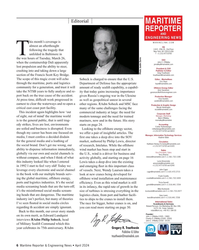 )
April 2024 - Maritime Reporter and Engineering News page: 6
)
April 2024 - Maritime Reporter and Engineering News page: 6Editorial MARITIME REPORTER AND ENGINEERING NEWS his month’s coverage is M A R I N E L I N K . C O M almost an afterthought HQ 118 E. 25th St., 2nd Floor following the tragedy that New York, NY 10010 USA T +1.212.477.6700 Tunfolded in Baltimore in the wee hours of Tuesday, March 26, CEO John C.
-
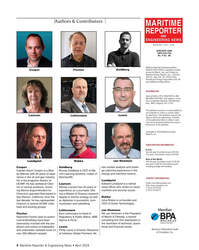 )
April 2024 - Maritime Reporter and Engineering News page: 4
)
April 2024 - Maritime Reporter and Engineering News page: 4Authors & Contributors MARITIME REPORTER AND ENGINEERING NEWS M A R I N E L I N K . C O M ISSN-0025-3448 USPS-016-750 No. 4 Vol. 86 Maritime Reporter/Engineering News (ISSN # 0025-3448) is published monthly Cooper Fischer Goldberg except for March, July, and October by Maritime Activity Reports, Inc.
-
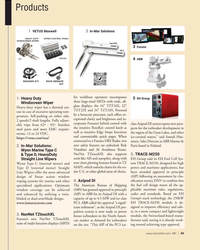 )
April 2024 - Marine News page: 43
)
April 2024 - Marine News page: 43Samuli Hän- https://vetus.com/usa/ connected to a Furuno DRS Radar, two ninen, Sales Director at ABB Marine & new safety features are unlocked: Risk Ports based in Finland. 2. In-Mar Solutions: Visualizer and AI Avoidance Route. Wynn Marine Type C NavNet TZtouchXL also supports & Type D, HeavyDuty
-
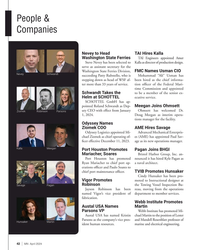 )
April 2024 - Marine News page: 42
)
April 2024 - Marine News page: 42Ziomek as chief operating of- es (AME) has appointed Paul Sav- ? cer effective December 11, 2023. age as its new operations manager. Kalla Meegan Port Houston Promotes Pagan Joins BHGI Mariacher, Soares Bristol Harbor Group, Inc. an- Port Houston has promoted nounced it has hired Kyle Pagan as Ryan
-
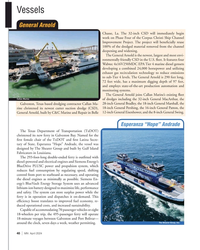 )
April 2024 - Marine News page: 40
)
April 2024 - Marine News page: 40, built by C&C Marine and Repair in Belle 12-inch General Eisenhower, and the 8-inch General Swing. Esperanza “Hope” Andrade The Texas Department of Transportation (TxDOT) christened its new ferry in Galveston Bay. Named for the ? rst female chair of the TxDOT and ? rst Latina Secre- tary of State, Esperanza
-
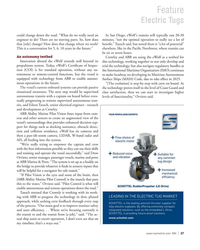 )
April 2024 - Marine News page: 37
)
April 2024 - Marine News page: 37Pilot Vision fuses input from cam- eras and other sensors to create an augmented view of the vessel’s surroundings that provides enhanced decision sup- port for things such as docking assistance, obstacle detec- tion and collision avoidance. eWolf has six cameras and then a pan-tilt-zoom camera, LIDAR,
-
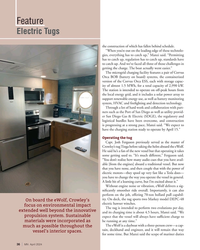 )
April 2024 - Marine News page: 36
)
April 2024 - Marine News page: 36a total capacity of 2,990 kW. The station is intended to operate on off-peak hours from the local energy grid, and it includes a solar power array to support renewable energy use, as well as battery monitoring system, HVAC and ? re? ghting and detection technology. Through a lot of hard work and collaboration
-
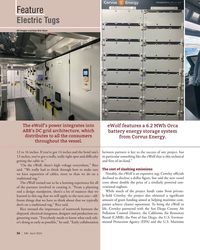 )
April 2024 - Marine News page: 34
)
April 2024 - Marine News page: 34funding aimed at helping maritime com- panies achieve cleaner operations. To bring the eWolf to don’t on a traditional tug,” Rice said. Rice stressed the importance of teamwork between the life, Crowley partnered with the San Diego County Air Pollution Control District, the California Air Resources shipyard
-
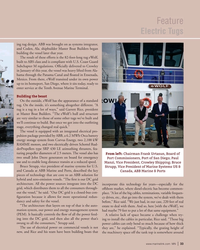 )
April 2024 - Marine News page: 33
)
April 2024 - Marine News page: 33was heavy lifted from Ala- bama through the Panama Canal and ? oated in Ensenada, Mexico. From there, eWolf transited under its own power up to its homeport, San Diego, where it sits today, ready to enter service at the Tenth Avenue Marine Terminal. Building the beast On the outside, eWolf has the appearance
-
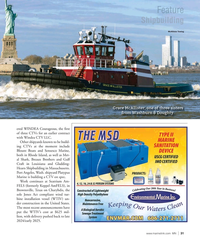 )
April 2024 - Marine News page: 31
)
April 2024 - Marine News page: 31Marine, both in Rhode Island, as well as Met- al Shark, Breaux Brothers and Gulf Craft in Louisiana and Gladding- Hearn Shipbuilding in Massachusetts. Port Angeles, Wash. shipyard Platypus Marine is building a CTV on spec. Work continues at Seatrium Am- FELS (formerly Keppel AmFELS), in Brownsville, Texas
